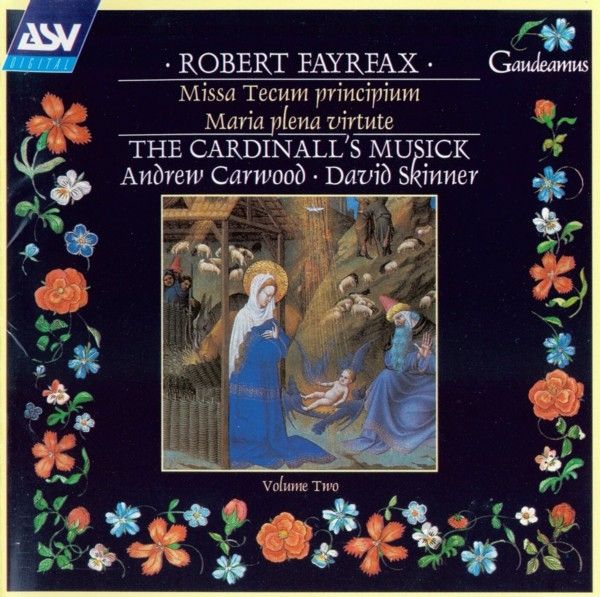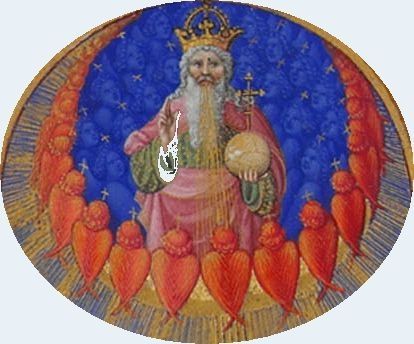Robert FAYRFAX / The Cardinall's Musick
Missa Tecum principium · Maria plena virtute

medieval.org
AS&V Gaudeamus 145
1995
Robert FAYRFAX
1464—1521
1. Tecum principium [0:44]
plainsong antiphona
Missa Tecum
principium
2. Gloria [11:29]
3. Credo [13:04]
4. Sanctus [12:37]
5. Agnus Dei [12:21]
Music for Recorders
The Frideswide Consort
6. Mese tenor [1:18]
7. O lux beata Trinitas [2:30]
8. Paramese tenor [1:25]
9. Maria plena
virtute [15:25]
THE CARDINALL'S MUSICK
Andrew Carwood
Sopranos: Carys Lane, Rebecca Outram, Olive Simpson
Altos: David Gould, Robert Harre-Jones, Michael Lees
Tenors: Simon Berridge, Julian Stocker, Matthew Vine
Baritones: Matthew Brook, Robert Evans, Donald Greig
Basses: Simon Birchall, Robert Macdonald, Michael McCarthy
THE FRIDESWIDE CONSORT
Recorders: Caroline Kershaw, Jane Downer, Christine Garratt,
Jean McCreery
Editions prepared by
David Skinner
Producer: David Skinner
Recording Engineer: Martin Haskell
Recorded in: Fitzalan Chapel, Arundel Castle, Arundel, 10-11 May
1995
Front cover painting:
Très Riches Heures du Duc de Berry, PE 4935 Ms. 65/1284 f.44v
The Nativity, by Pol de Limbourg. Musée Conde, Chantilly;
courtesy of Giraudon / Bridgeman Art Library

THE WORKS OF ROBERT FAYRFAX
Volume II
The music of Robert Fayrfax and his contemporaries marks the end of a
musical tradition which had its roots in the very foundations of
Britain's ancient chapels and cathedrals. The great English choral
foundations of today technically date from the middle of the sixteenth
century when Protestant reformers replaced the Latin Rite with a new
vernacular service still in use today. A break of more than 450 years
with the earlier Catholic tradition has somewhat clouded our perception
of the circumstances in which these composers lived and worked, and has
distanced us from the ethical and religious beliefs which inspired
their musical creations. The revival of early Tudor polyphony did not
occur until the middle of the present century, and it is only since the
1970s that it has been sung regularly by professional and amateur
choirs. So, effectively for the first time since the English
Reformation, a new performing tradition of this music has emerged,
although this movement has invariably been accompanied by an
impassioned concern for so-called authenticity.
It is virtually impossible to achieve this in early vocal music, and it
is doubtful whether we are much closer to producing a performance which
would be recognisable to early sixteenth-century composers. The main
obstacle is that we have no clues as to what these choirs sounded like,
nor can we be certain of what was then considered a good singing voice
or 'correct' intonation. All we have to go on are the surviving
archival documents, and what can be gleaned from the music itself.
While there can be little doubt that the scoring of early Tudor
polyphony falls into the five basic vocal timbres of treble, alto,
tenor, baritone (or second tenor) and bass (as opposed to the
long-discredited 'high-pitch' scoring of high treble, low treble, alto,
tenor and baritone), it is more difficult to establish precisely how
many singers participated in a given performance. Taverner's choir at
Cardinal College, Oxford (now Christ Church) boasted an unusually large
choir of 12 men and 16 boys, while most other collegiate foundations
worked with much smaller numbers. It is difficult to identify a
specific choir for which Fayrfax composed, although some of his works
can be linked to St Alban's Abbey where he is buried. He was also a
Gentleman of the Chapel Royal from at least 1496, so it is likely that
several of his compositions were written for this elite band of
musicians. However, considering his stature as the most celebrated
composer of his generation, and indeed a favourite of Henry VIII,
Fayrfax's music would have almost certainly been performed in any of
the important choral establishments practised in the art of singing
polyphony — so a variety of 'authentic' performing forces can be
suggested.
All five of Fayrfax's surviving masses are copied into both the Lambeth
and Caius Choirbooks. The former was likely to have been in use at
Arundel College in Sussex after c.1524 and the latter was a gift from
the master of Arundel College, Edward Higgons, to the free royal chapel
of St Stephen in Westminster, where Nicholas Ludford was employed from
c.1521. The performing forces at both institutions were remarkably
similar. Arundel employed six choristers (two of which were in
acolyte's orders) and four professional singing-men. The numbers of the
latter were occasionally bolstered by the employment of one or two
extra clerks and probably some of the residential chaplains, several of
whom are known to have been skilled in polyphony. St Stephen's had
seven boys and four clerks; in addition there were also 13 vicars
choral. Therefore the music copied into the Caius and Lambeth
Choirbooks and thus performed in Westminster and Arundel, respectively,
would have been sung by an average of six or seven boys and four to
probably no more than 12 men (the role of the vicars choral at St
Stephen's and the chaplains at Arundel remains ambiguous). The royal
chapel of St Stephen within the Palace of Westminster was destroyed by
fire in 1834. However, the collegiate chapel of the Holy Trinity,
Arundel, survives intact within the precincts of Arundel Castle, and it
this very chapel which serves as the venue for these recordings of
Fayrfax's music. While The Cardinall's Musick cannot profess to have
reproduced a choral sound that would have been familiar to members of
Arundel College in the late 1520s, there is the assurance that the
acoustics on this recording are virtually the same as those experienced
by our early sixteenth-century counterparts.

This volume in the present series of Fayrfax's complete works takes as
its centrepiece the Christmas Mass Tecum principium. In
contrast with the elaborate and highly cerebral doctorate Mass O
quam glorifica (ASV CD GAU 142), Tecum principium is more
typical of the early Tudor mass cycle as it developed in the works of
Nicholas Ludford. The Mass is also copied into the famous
Forrest-Heyther partbooks and the slightly later Peterhouse partbooks,
which together provide a completely different version of the beginning
of the second section of the Gloria (from 'Qui follia peccata mundi...'
to '...suscipe deprecationem nostram'). This version is stylistically
superior to that found in the Caius and Lambeth Choirbooks and is the
one recorded here. (All of these sources post-date Fayrfax's death in
1521. It would appear that the scribe of Caius and Lambeth either did
not have access to Fayrfax's reworking of this movement —
assuming that it is his — or that it was one which was already
long in use at Arundel and preferred to the revised version.) The Mass
is written in a contemplative style throughout and Fayrfax demonstrates
his expert handling of long and sustained textures, especially in the
sections written for full choir. Short statements of imitation are
frequently introduced, not to accentuate important passages of the text
but to highlight isolated musical ideas (note for example the repeated
motives in each 'Osanna'). The most striking of these is a simple
three-note melodic cell structured around the interval of a fourth
(B♭-G-F) which makes a brief appearance in each movement. At the end of
the Agnus Dei, however, the upper interval of this cell is extended by
one tone (C-B♭-G-F), alternating between the treble and tenor parts
with the alto imitating down a fourth. Listen here for the wonderful
series of unprepared 4-3 suspensions, quite unconventional to the
period although masterfully crafted to a most beautiful and somewhat
modern effect.
Maria plena virtute is arguably Fayrfax's most accomplished
work. The Marian text, which is essentially an account of Christ's
passion, cannot be traced to a contemporary literary source (see Andrew
Carwood's note on its liturgical significance printed below). The work
is conceived on a grand scale and constructed with a number of sections
for a variety of reduced voice combinations, performed here with solo
voices. Fayrfax's known instrumental works, all in four parts, are also
included on this recording. Mese tenor and Paramese tenor
are companion puzzle canons based on a scalic cantus firmus beginning
on A in the former and B in the latter. O lux beata trinitas is
freely composed and begins with a short faburden set to these words in
the manuscript, while the remainder is left untexted. (Fayrfax also
composed a four-part setting of 'Ut re mi fa sol la', of which only the
bass survives.) The written style of these works leaves little doubt
that they were intended for instruments rather than voices; they were
probably composed for private or courtly entertainments. The recorder
consort was certainly a favourite instrumental combination of Henry
VIII. By his death in 1547 the King owned at least 76 recorders, stored
in consorts in elaborately carved cases.
© 1995 David Skinner
SOURCES
Misse Tecum principium: Cambridge University Library,
Gonville and Caius MS 667, p. 142 (late 1520s);
Lambeth Palace Library, MS 1, f. 1v (late 1520s);
Oxford, Bodleian Library, MSS Mus. Sch. e.376-80, ff. 68, 63, 71, 56,
58 (c.1530; the Forrest-Heyther partbooks);
Cambridge University Library, Peterhouse MSS 471-4, ff. 45v, 42, 49v,
41 (c.1540s; lacks tenor).
Maria plena virtute: Cambridge, Peterhouse MSS 472-4, ff.
7, 9v, 7v (lacks treble and tenor);
Oxford, Bodleian Library, MSS Mus. e.1-5, ff. 46, 45v, 46, 43, 41v
(c.1585; 'John Saldler's partbooks);
Oxford, Bodleian Library, Tenbury MS 1464, f. 24 (c.1575; bass only);
London, British Library, MS Roy.Mus.Lib. MS 24.d.2, f. 146v (c.1600,
John Baldwin; verse 'Rex amabilis' only, attrib. to Taverner);
also listed in a manuscript index which dates from the early 16th
cent., now in Merton College Library, Oxford (MS 62.F.8).
Instrumental music:
Mese tenor and Paramese tenor: London, British Library,
Add. MS 31922 (Henry VIII Manuscript), ff. 57-8. See D. Stevens, ed. Music
of the Court of Henry VIII, Musica Britannica, 18 (London: Stainer
and Bell, 1973), p. 106;
O lux beata trinitas: London, British Library, Add. MS 4911. See
E. B. Warren, ed. Robert Fayrfax: Collected Works, Corpus
Mensurabilis Musicae, 17/2 (1959-66), p. 57.
Music edited by David Skinner. Missa Tecum principium and Marla plena
virtute are published by The Cardinall's Musick Edition, P. O. Box 243,
Oxford, ENGLAND.

A NOTE ON Maria plena virtute
So great was the devotion to Our Lady in pre-Reformation England that
many texts were written in her honour, for Mary is the great allegory
of the Church. She was present when the Church was born, that is when
Christ died. Through her sorrow, as expressed in the Stations of the
Cross for example, those in prayer can relate to the pain of the
Passion and Crucifixion. She makes understandable the mystery of
redemption through Christ's death and focuses human feeling in an
accessible way.
Votive antiphons produced in early Tudor England had various forms, but
the setting Maria plena virtute seems exceptional. It is closer
to a private musing on the matter of the Passion rather than a formal
prayer to the Virgin. It begins in a predictable way with an invocation
to Mary, but, after the opening trio and duet, moves swiftly to the
Passion narrative, with a gentle swaying back and forth from narrative
and personal interjection rather like the chorus in a play.
Whilst contemplating the forgiveness for which he so longs, the
penitent is reminded of Christ's forgiveness on the Cross and so begins
the first reference to St Luke's Gospel (23, vv. 39-43). Then the focus
is widened as the writer moves to the scene at the foot of the Cross
when Christ commits the care of his mother to the beloved disciple (St
John 19, vv. 25-7). Here again the writer casts his mind back to the
words from St Mark concerning the son of Man who comes not to be served
but to serve (St Mark 10, v. 44). Then a jolt back to the present and
St John, however not simply 'I thirst' as in the gospel narrative, but
'Sitio salutem genuis' (I thirst for the salvation of Man), which once
again is the cue for personal musing before a movement to Matthew (27,
v. 46) and back to John (19, v. 30). There is further drawing on
scripture at the mention of the sword piercing Mary's heart (St Luke 2,
v. 35) and the mission of Joseph of Arimathea and Nicodemus (St John
19, vv. 38-42). The end of the work returns the attention to Mary and a
glimmer of light given by the words 'regina caeli' (a Paschaltide
reference to the Virgin).
It is difficult to ascribe any particular season to votive antiphons,
yet Maria plena virtute, with its concentration on the gospel
passion narratives and its ironic reference to 'regina caeli', seems
ideally suited to Holy Week. This is an intensely personal devotion to
which Fayrfax has responded in a most personal style. There is little
melismatic writing compared with his contemporaries; indeed the
syllabic word setting in places seems more reminiscent of the Continent
than England. 'Ora pro me', pleads the writer (not the usual 'ora pro
nobis'), to which Fayrfax responds with remarkable melodic and harmonic
subtlety and with such care over the word setting, the like of which
would not be a regular feature in English church music until later in
the century.
© 1995 Andrew Carwood





